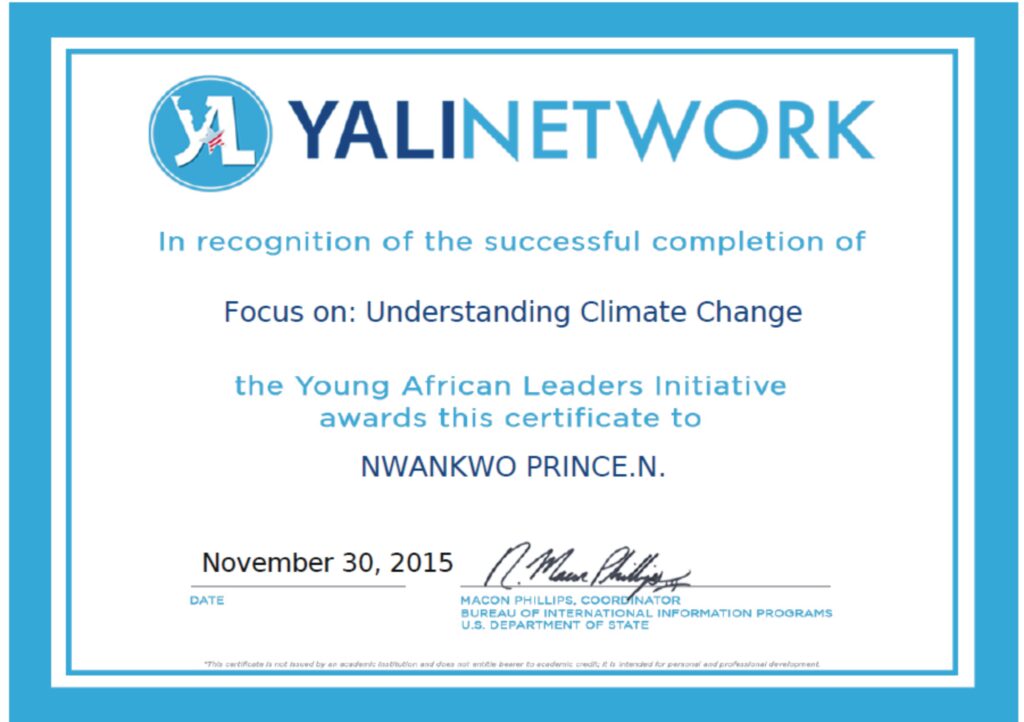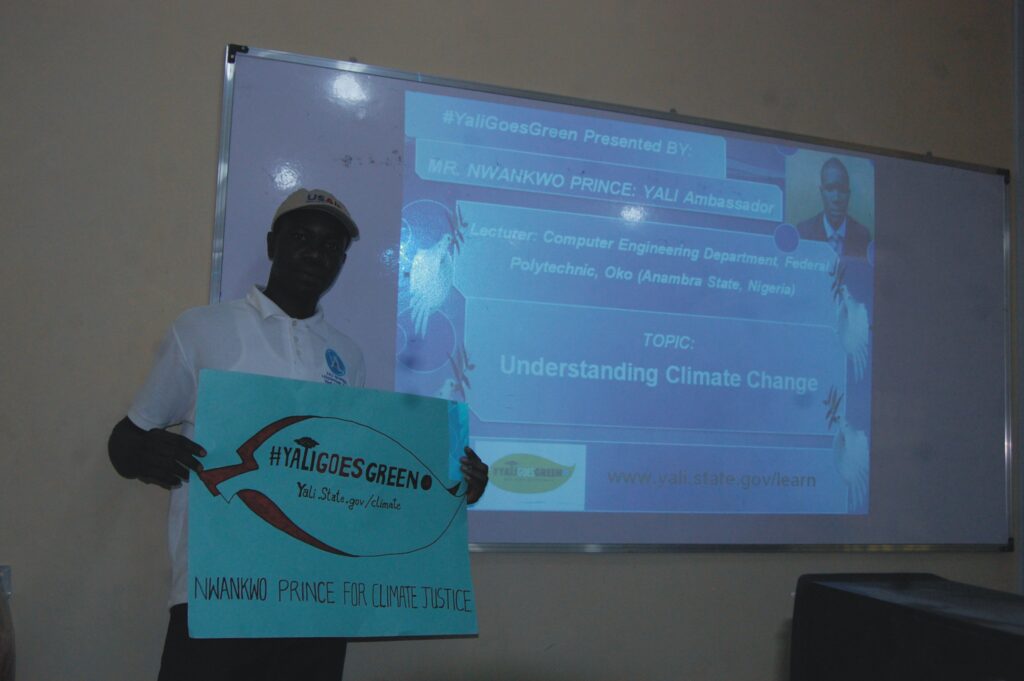
UNDERSTANDING CLIMATE CHANGE

UNDERSTANDING CLIMATE CHANGE (Climate Change Advocacy Programme) – #YALIGOESGREEN
A. Project Overview
“Understanding Climate Change” is an innovative climate advocacy and public enlightenment programme conceived by Prince Nwankwo, through the Prince Technology and Community Development Foundation. The program aims to raise awareness, enhance local resilience, and trigger community-driven climate action in Nigeria, with a focus on marginalized and highly vulnerable communities whose residents are yet to be enlightened on the effects of climate change and strategies they can embrace to adapt and flourish.

This advocacy effort traces its roots to 2016, when Prince Nwankwo facilitated the maiden edition of the programme, a groundbreaking initiative that earned him the prestigious Green Champion Award from the U.S. Department of State. It was a 1-week public awareness and advocacy programme that provided cutting-edge information to young Nigerians on the impacts of climate change and actions towards reducing its overall vulnerability. This recognition affirmed the global relevance and impact of the work, positioning it as a replicable model for grassroots climate education and action.

Today, the programme is being expanded and scaled to reach wider communities across the region. It equips participants with cutting-edge knowledge, practical tools, and behavioural strategies to reduce vulnerability, adapt to altered climate conditions, and drive eco-conscious practices for a more sustainable future.
B. Project Goals
- Enhance community awareness of climate change, its causes, and far-reaching impacts.
- Empower vulnerable groups (youth, women, and farmers) with local adaptation and mitigation strategies.
- Stimulate behavioural change towards eco-friendly practices through advocacy and education.
- Support policy advocacy at the local level to integrate climate risk awareness in community planning.
- Promote climate-smart livelihoods and sustainability practices that align with global climate action goals.
C. Key Activities
- Town hall Advocacy Workshops on climate change, adaptation, and mitigation.
- Community sensitization campaigns.
- School outreach to educate the next generation.
- Training sessions on climate-smart agriculture, waste management, and renewable energy.
D. Impact and Importance
Helps reduce climate vulnerability by promoting knowledge and proactive behaviour. • Strengthens community-level resilience to floods, droughts, heatwaves, and other climate risks. • Encourages climate-smart innovations and eco-friendly livelihoods. • Addresses the climate information divide through localized education. • Inspires environmental leadership in local communities.
E. Primary Sustainable Development Goals (SDGs) Addressed by the Project This project aligns with and contributes directly to the following Sustainable Development Goals (SDGs):
- SDG 13 – Climate Action
- Strengthens resilience and adaptive capacity through education and grassroots advocacy.
- SDG 4 – Quality Education
- Provides climate literacy to marginalized groups and promotes lifelong learning.
- SDG 11 – Sustainable Cities and Communities
- Equips communities to plan for climate risks and enhance local sustainability.
- SDG 3 – Good Health and Well-being
- Addresses health vulnerabilities linked to climate extremes (e.g., heatwaves, floods).
- SDG 7 – Affordable and Clean Energy
- Promotes awareness of renewable energy as a climate mitigation strategy.
- SDG 12 – Responsible Consumption and Production
- Advocates waste reduction, recycling, and eco-conscious habits.
- SDG 17 – Partnerships for the Goals
- Fosters collaboration among schools, government, and traditional institutions.
F. Call to Action
The Understanding Climate Change Advocacy Programme is not just a campaign, it is a movement for environmental justice and sustainability. We are calling on development partners, government agencies, schools, climate-focused NGOs, and community-based organizations to collaborate with us in scaling this vital initiative. Let’s work together to bridge the climate knowledge gap, build resilient communities, and create a greener, safer, and more informed Nigeria.











I cannot thank you enough for the blog article.Really thank you! Keep writing.
I think this is a real great blog article.Really looking forward to read more. Cool.
Wanted posting. Loads of excellent writing here. I wish I saw it found the site sooner. Congrats!
Fantastic blog post.Much thanks again. Much obliged.
Im grateful for the post.Really thank you! Great.
Really appreciate you sharing this post. Awesome.
I truly appreciate this blog.Really looking forward to read more.
Really appreciate you sharing this article post.Much thanks again.
Major thankies for the blog post.Much thanks again. Want more.
I really enjoy the blog article.Much thanks again. Fantastic.
Thank you ever so for you blog post.Really looking forward to read more. Cool.
A big thank you for your post. Keep writing.
Great article post.Thanks Again. Want more.
I think this is a real great blog article.Much thanks again. Great.
Now I am going to do my breakfast, later than having my breakfast coming again to read other news.
Thanks for sharing this kind of nice opinion, article is nice, thats why i have read it completely
HRIBfF Say, you got a nice blog article.Thanks Again. Want more.
This is one of the best informative site i have come across recently.
Is there any details regarding to this subject in different languages?
Awesome article.
Thank you ever so for you blog. Awesome.
Hurrah, that’s what I was searching for, what a material!
present here at this blog, thanks admin of this web site.